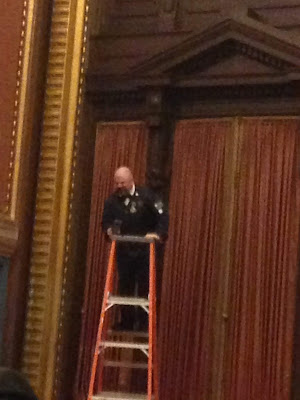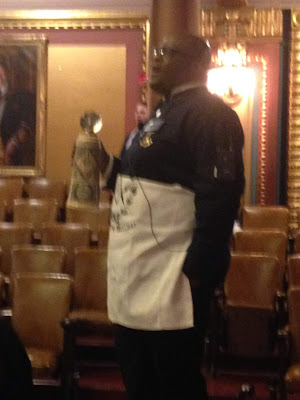 |
|
Self-Portrait, by Thomas Cole, 1836, oil on canvas.
Owned by
New-York Historical Society.
|
“My Birthday. Once more has the Wheel of Life revolved [and]
again advances on the untried road of Another Year.”
Thomas Cole
Speaking of 19th century American painters who were Ohio
Freemasons (see post below), today is the 219th anniversary of the birth of
Thomas Cole. He will be associated with New York forever, but it was Lodge of Amity
5 in Zanesville, Ohio where he became a Mason. Born in England, Cole emigrated
to the United States in 1818 with his family, settling in Steubenville, Ohio.
It is the Hudson Valley of New York that is inextricably
bonded to Cole the artist, thanks to his landscapes depicting, or otherwise
inspired by, the scenic region.
Masonic messages are found in Cole’s works. These are not
overt, but are recognizable by the initiated eye. I don’t think The Architect’s
Dream is among those, but still is worth discussing:
 |
| In the distance, an Egyptian pyramid looms over Egyptian, Greek, and Roman temples while, in the foreground, a Gothic-style church juts from the trees. Oil on canvas, 1840. |
Cole’s works associated with Masonic thought are his four The Voyage of
Life oil-on-canvas paintings from 1842, showing Childhood, Youth, Manhood, and Old Age.
 |
|
The Voyage of Life: Childhood
|
 |
|
The Voyage of Life: Youth
|
 |
|
The Voyage of Life: Manhood
|
 |
|
The Voyage of Life: Old Age
|
The National Gallery of Art in Washington, DC holds and
exhibits these paintings. Its website says:
Cole’s renowned four-part series traces the journey of an
archetypal hero along the “River of Life.” Confidently assuming control of his
destiny and oblivious to the dangers that await him, the voyager boldly strives
to reach an aerial castle, emblematic of the daydreams of “Youth” and its
aspirations for glory and fame. As the traveler approaches his goal, the
ever-more-turbulent stream deviates from its course and relentlessly carries
him toward the next picture in the series, where nature’s fury, evil demons,
and self-doubt will threaten his very existence. Only prayer, Cole suggests,
can save the voyager from a dark and tragic fate.
From the innocence of childhood, to the flush of youthful
overconfidence, through the trials and tribulations of middle age, to the hero’s
triumphant salvation, The Voyage of Life seems intrinsically linked
to the Christian doctrine of death and resurrection. Cole’s intrepid voyager
also may be read as a personification of America, itself at an adolescent stage
of development. The artist may have been issuing a dire warning to those caught
up in the feverish quest for Manifest Destiny, that unbridled westward
expansion and industrialization would have tragic consequences for both man and
nature.

























































































